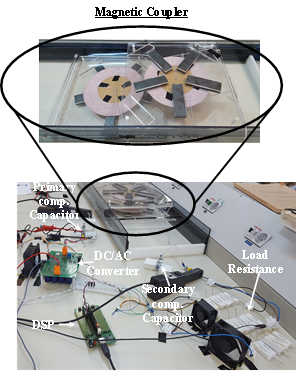Inductive Charging of Electric Vehicles
Inductive charging allows the wireless energy transfer between the charging station and the vehicle. The operational principle of inductive charging is similar to a transformer; energy is transferred through an air-gap from a primary to a secondary coil. In the case of inductive charging, however, the two coils operate as a loosely coupled transformer, allowing the energy transfer through a relatively large air-gap. In the implemented design the magnetic coupler comprises the primary and secondary coil, while ferrite bars are also used in order to enhance and guide the magnetic flux between the coils. Moreover, a DC/AC converter has been developed in order to provide a high frequency current in the primary coil, which is necessary in inductive charging applications to ensure the wireless transfer of high energy amounts. Compensation capacitors are also employed both in the primary and secondary side n in order to increase the power transfer capability as well as the efficiency of the system.
The experimental setup has also been designed considering dynamic inductive charging which allows the wireless transfer of energy while the EV moves over the station. In this respect, the design allows the movement of the secondary pad over the primary, while a control scheme has been specifically developed to increase the efficiency of the system, considering the movement of the vehicle over the station. More specifically, the system can detect when the vehicle enters sections of high or small efficiency while the secondary pad moves over the primary and adjust the input power accordingly in order to significantly decrease the power losses over the whole movement range.

